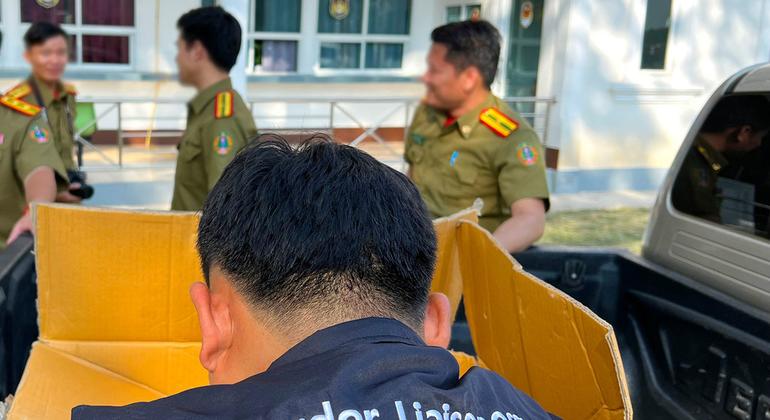A Thai Navy speedboat speeds through the brown, murky waters of the Mekong River near the northern Thai border town of Chiang Saen. To the right is Laos, where huge foreign-invested construction projects rise from the lush undergrowth along the riverbank, and ahead to the left are the dense jungles of Myanmar.
It is the famous Golden Triangle, where opium was historically grown to produce heroin for export, but where, in recent years, the trade in even more deadly and profitable synthetic drugs has taken over.
Thailand, Laos and Myanmar are at the forefront of the illicit trade in Asia, a business dominated by transnational criminal organizations.

An unlikely seizure
The Thai ship’s crew is feeling optimistic after the recent seizure of 6.4 million pills of methamphetamine, a banned and highly addictive synthetic drug known locally as yaba.
“I am surprised but also very pleased to have seized this amount of yaba,” Captain Phakorn Maniam, head of the Operations and Intelligence Section of the Royal Thai Navy’s Mekong River Unit, told UN News.
“Normally this amount of drugs is seized on land; it is a difficult operation to stop criminals in the middle of the river,” he said, “so I am especially proud of our crew, who are so dedicated to protecting our country and our people.”
A few kilometers downriver, in the small town of Houay Xai, on the Laotian bank of the Mekong, border authorities celebrate their own major drug seizure; The night before, after receiving a tip, a ground patrol captured some mules carrying 500 kilos of crystal methamphetamine. The previous month they seized 7.1 million pills of this drug in the same area.
The drugs seized in Laos and Thailand came from industrial-scale illegal labs run by militias and criminal gangs in the remote mountainous jungles of Myanmar’s northern Shan state, transiting both countries to the Thai capital Bangkok, but also via throughout Southeast Asia and to lucrative markets as far away as Japan, South Korea, New Zealand and Australia.
It is difficult to estimate with certainty the amount of synthetic drugs being manufactured in Myanmar, but some estimates suggest that many hundreds of tons are trafficked out of the country.
Despite the seemingly relentless flow of drugs, the Thai and Laotian authorities are making some progress, thanks in part to the support of the United Nations Office on Drugs and Crime (ONUDC), which promotes a regional network that captures information.

Agent C, stationed in Houay Xai, who did not want to be named for security reasons, said that cooperation with Thai border agencies has improved the response to smuggling through regular calls, face-to-face meetings and other communications.
“Thanks to this cross-border collaboration and the exchange of information, we have been able to fight against drug trafficking and also against other types of transnational organized crime,” he stressed.
Thai and Lao crime-fighting authorities are collaborating more closely through UNODC’s Regional Border Management Programme, which created a network of border liaison offices to strengthen cross-border cooperation and information sharing .
The network has more than 120 offices and spans all of Southeast Asia, from Myanmar in the west to China in the east and Indonesia in the south, as well as Thailand, Cambodia and Vietnam.
With the support of the UN agency, the network is consolidating itself in the fight against “one of the largest drug trafficking corridors in the world”, according to Jeremy Douglas, regional representative for Southeast Asia and the Pacific of the Office .

According to Douglas, the challenges in disrupting this transnational trade are immense.
“In the Golden Triangle and inside Myanmar there are complex governance issues at stake, with fragmented armed groups and militias involved in drug trafficking and other illicit businesses controlling the territory,” he explained.
“At the same time, these groups operate in very remote locations and, in some cases, along very porous and accessible borders. It is easy to traffic drugs and illicit goods in and out of Myanmar, and the situation is very difficult for its neighbors to deal with.“, he added.
Douglas described the increase in the production of synthetic drugs in recent years as an “unprecedented” phenomenon and considers that collaboration between countries is “essential” to prevent their trafficking
“This is a shared responsibility; tackling transnational crime requires rapid collaboration between states, especially along border areas,” he stressed.
But the regional drug trade is far from the only one. Chemical precursors to make synthetic drugs are smuggled into Myanmar in far greater quantities than the drugs leaving the country. People, wild animals, wood, and weapons are also traded.
In such a complex environment, new knowledge is needed to face recent challenges. As part of its support to the network, the Office has established training partnerships with agencies throughout South East Asia.

Learn to increase the number of seizures
On Highway 1, about 40 kilometers south of the Thailand-Myanmar border, Lt. Col. Amonrat Wathanakhosit leads a practical exercise focused on searching vehicles for contraband.
“Our students use UNODC knowledge and training and learn to question drivers and get used to their behavior. Our students become more confident in identifying which drivers may be concealing synthetic drugs.”
Unlike heroin, the production of which is limited by the natural cycle of poppy cultivation, methamphetamine can be manufactured virtually whenever desired, as long as precursors and other chemicals are available.
The collaboration of governments with the support of the Office helps to stop the flow of drugs, although it is generally recognized that seizures represent only a small percentage of the drugs trafficked through the region.
Officers like Lt. Col. Wathanakhosit acknowledge the challenges they face, but speak for many when they say their work trying to stop drugs “is critical to the security of my country.”


![[Img #74664]](https://thelatestnews.world/wp-content/uploads/2024/12/James-Watson-The-controversial-genius-behind-the-double-helix-150x150.jpg)







